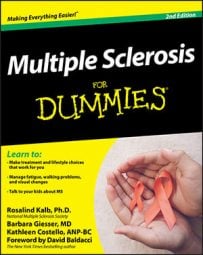Of the 400,000 people in the United States with multiple sclerosis (MS), approximately 8,000 to 10,000 of them are children or adolescents. Initial symptoms have been seen as early as 13 months old, with a diagnosis as young as 2 years old. The majority, however, are diagnosed in their teens.
An additional 10,000 to 15,000 youngsters have experienced at least one symptom suggestive of MS. Some — but certainly not all — of these will go on to develop MS. Although in most cases they won’t actually be diagnosed until they’re adults. If you have a young child or teen with multiple sclerosis (MS), you should know right up front that you aren’t alone and that a lot of resources are available to help you and your child.
Check out “Young Persons with MS: A Network for Families with a Child or Teen with MS,” which is a support program developed collaboratively by the National MS Society and the MS Society of Canada. You can get more information about the Network by calling 800-344-4867, or by going online or e-mailing.
The advent of magnetic resonance imaging (MRI) technology, combined with a growing awareness of pediatric MS among adult and pediatric neurologists and pediatricians, has made it possible to identify children with MS earlier than ever before. Even though the information about these kids is accumulating gradually, we want to fill you in on what’s known so far:
As is true with adults, no one knows why one child gets MS and another doesn’t. In general, it’s thought that a person with a certain genetic predisposition comes into contact with some kind of environmental trigger prior to adolescence that causes the disease to occur.
Doctors still don’t know what the trigger is or what causes the disease to become active so early in some children. However, we guarantee you that neither you nor your child did anything to make it happen.
You can’t predict how your child’s MS will progress. However doctors do know that most adults with MS remain able to walk, even though they may need a cane or other assistive device to help them.
Right now, the diagnostic criteria for MS in children are the same as in adults. As more information is gathered about these kids, however, the criteria may ultimately be revised somewhat for this younger group.
Here’s the challenge when it comes to diagnosing younger folks: When a child or teen goes to the doctor with a single episode of neurologic symptoms that are characteristic of demyelination (damage to the myelin coating and nerve fibers in the central nervous system), the doctor needs to decide if this is a one-time event in the child’s life or the first event in what will eventually turn out to be MS.
To complicate matters, it isn’t unusual for children to experience single neurologic events known as acute disseminated encephalomyelitis (ADEM). Although some neurologic symptoms and signs of ADEM are similar to those of MS — such as vision problems or difficulties with balance, sensation, or strength — others are quite different.
Like treatment in adults, the treatment of MS in children involves managing acute attacks, modifying the disease course, and managing the symptoms. Unfortunately, though, many of the medical treatments described in this book haven’t been studied in children under 18.
And although several medications have been approved by the U.S. Food and Drug Administration (FDA) for use in adults with MS, none has been specifically approved for use in pediatric MS. This means that your child’s physician has to rely on his or her clinical judgment — and that of experts in the field — when making decisions about what to prescribe.
Cognitive symptoms are an important issue for any person with MS, but they’re of particular concern in kids because of their potential impact on school performance. Because cognitive changes (including problems with attention, memory, information processing, and problem-solving) can occur early in the disease — even as a first symptom — it’s important to educate yourself about them so you can be on the lookout.
If you (or the teacher) notice any changes in your child’s performance, consider a cognitive evaluation. The goal is to identify any changes early on so that the school can provide whatever assistance your child needs to learn comfortably and function at his or her best.
The Network for Families can give you additional information about the rights of children in public school districts, private schools, and post-secondary schools. Contact the Network by e-mail to receive a copy of Managing School-Related Issues: A Guide for Parents with a Child or Teen Living with MS and Students with MS & the Academic Setting: A Handbook for School Personnel.

